TOYOTA RECALL AND ACCELERATOR CRISIS IN 2009 AND 2010

2010 Matrix RECALLED In late 2009 and early 2010, Toyota was stung be a series of recalls — most involving accelerator and brake problems — that raised serious questions about Toyota safety and reliability. Some drivers complained that their Toyota vehicles suddenly accelerated and they were unable to stop them even when they took their foot off the gas pedal. Others said they put their foot on the brake pedal and nothing happened.
Toyota was forced to recall over 8 million vehicles. The recall problem became the worst crisis in Toyota’s history as a company. It not only damaged Toyota it raised questions about the quality and integrity of Japanese industry and management.
Not only did the safety of the vehicles become an issue, Toyota’s response was also criticized. The car company was accused of stonewalling and failing to act quickly to respond to the problems. More than 2,000 drivers complained of sudden acceleration between 1999 and 2009. Critics blamed Toyota quality control and procedures for analyzing customer complaints which are key to addressing problems quickly. The U.S. Department of Transportation (DOT) said that Toyota only decided to make the recalls after it was pressured to do so by media reports and the DOT.
At its peak, the attacks on Toyota resembled a witch hunt with sensational stories in the media and stinging criticism by politicians U.S. government officials. U.S. Transportation Secretary Ray LaHood, for example, said his agency was going to hold “Toyota’s feet to fire” to make sure they did what was necessary to make their cars safe for the driving public” and promised to “get into the weeds on electronics” to find out what was wrong. At one point LaHood advised Toyota owners not to drive their cars but quickly retracted the statement. But not before a lot damage had been done.
The Wall Street Journal said Toyota’s “image as a safety and quality leader was under threat.” Even before the recalls not a single Toyota made the list of safe cars by the Insurance Institute for Highway Safety in 2009. Eleven of its vehicles made the 27-car list in 2008.
Bill Saporito wrote in Time magazine: “A vapor lock seems to have seized Toyota’s mythologized corporate culture and turned one of the most admired companies into a bunch of failing gearheads. Not only is Toyota producing more flawed cars than in the past, but an organization known for its unrivaled ability to suss out problems, fix them, and turn them into advantages is clueless on all counts.”
Some of the sharpest criticism of Toyota came from politicians in Midwestern U.S. states, where American car makers are strongly represented — a congressmen from Illinois said that Toyota drivers “had no idea that their trusted vehicles had the potential to become, literally, killing machines” — while some of Toyota’s biggest American defenders were in politician in states that have Toyota plants. In Japan, there were strong feeling that the U.S. was unfairly targeting Toyota. The Japanese asked why the U.S. government was going after Toyota so aggressively while it was giving out billions of dollars to American car companies to bail them out. Some Japanese thought that a conspiracy was at work to help American automakers and make Japan a scapegoat for the U.S.’s economic problems.
Accidents Attributed to Sudden Acceleration in Toyota Vehicles
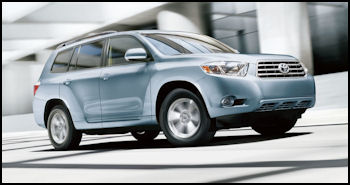
2010 Highlander RECALLED The sudden acceleration problem in Toyota vehicles first gained national attention in the United States after it was reported that a Lexus E350 went out of control in San Diego, California in September 2009, killing four passengers. In the crash, a car driven by 45-year-old highway patrol officer Mark Saylor, who was accompanied by his wife and two daughters, suddenly sped up on freeway and reached speeds of 190 kph before hitting a sports utility vehicle and flying off an embankment. The horrifying 911 call made from the car was played repeated in the American media. Toyota attributed the crash to an “improperly” placed driver-side floor mat. It mentioned no faults with the car and merely asked owners to make sure their floor mats were in their proper place. Relatives of the Saylor family sued Toyota for liability and negligence.
The U.S. government has linked 52 deaths to crashes allegedly caused by accelerator problems in Toyotas. State Farm Mutual Automobile Insurance Co., said that it submitted a report to U.S. transportation authorities in February 2004 about a rise of accidents due to sudden accelerator in Toyota vehicles.
Some of accidents are thought to have been caused by human error — namely slamming on the accelerator pedal instead of the brakes — not a Toyota defect. In March 2010,, a woman in Harrison New York reported that her Prius sped up on its own as she was backing down her driveway and crashed into a stone wall across the street despite her braking. Computer data from the car indicated the brakes “weren’t applied” and the gas pedal had been “depressed 100 percent.” Police in Chiba Prefecture investigated the report that an accident in July 2009 involving a Prius whose brakes didn’t work properly found that the brakes on the car were okay.
Richard Schmidt, a former UCLA professor and now an automobile industry consultant specializing in human motor skills, told the Los Angeles Times the problem almost always lies with drivers who steps on the wrong pedal: “When a driver says they have their foot on the brake, they are just plain wrong. The human motor system is not perfect, and it doesn’t always do what it is told.”
In some cases it seems that problem were cause by people who wanted their moment in the spotlight — their own reality TV experience so to speak. In late March 2010, a driver in San Diego reported that the gas pedal on his 2008 Prius got stuck, resulting in 151 kph ride on a Southern California freeway. The driver — 61-year-old James Sikes — claimed he stood on the brake pedal with all his might but still his car raced forward at alarming speed. He called 911, saying he could not slow down his car. A patrol car showed up and advised him to put on his emergency brake. Widely-shown video footage showed a police patrol car driving along side the Prius on the highway, helping the vehicle come to a stop.
An investigation by Toyota and the National Highway Safety Traffic Administration (NHTSA) found the brakes, safety system and accelerator of the car to be operating fine, plus the floor mat did not interfere with the gas pedal. There was no excessive wear on the brakes or no evidence that car sped out of control as the driver claimed. Several media reports raised questions about Sikes’s story.
Near Death Experience in a Lexus ES350

2010 Avalon RECALLED But that is not to say that all the sudden acceleration problems were fabricated or attributable to human error. As early as 2007 U.S. safety regulatory were aware of a large number of instances of acceleration problems in Toyota Lexus luxury cars. Among those that complained was a Tennessee woman , Rhonda Smith, who was gripped with fear when her Lexus ES350 suddenly accelerated in October 2006.
In a tearful testimony at a Congressional hearing in February 2010 she said her vehicle uncontrolledly accelerated and reached about 160 kph. “I had the emergency brake on while frantically shifting between all the gears but mainly had it in reverse,” she said. “I thought it was my time to die and called my husband...I figured he car was going to go its maximum speed, and I was going to have to put the car into the upcoming guardrail in order to prevent killing someone else and I prayed to God to help me.”
As she was calling her husband she said, “God intervened” and my car came very slowly to a stop, ending the ordeal. Later she and her husband became incensed by the way they were treated by Toyota and the NHTSA. She said they were either treated with indifference and blamed for causing episode themselves, which Smith was akin to being called a liar. She ended her testimony saying, “Shame on you Toyota for being so greedy and shame on you, NHTSA, for not doing your job.”
Toyota Floor Mat Recall

2010 Camry RECALLED Things begin relatively benignly in August 2009 Toyota recalled 690,000 cars in China over a problem with the electric window switches. It was the largest automobile recall on record in the China.
In September 2009, Toyota recalled 4.26 million vehicles in the United States over reports that unsecured driver-side floor mats could push on the accelerator pedal, causing the car to speed and making it hard to slow down or stop, creating the potential for a fatal accident. The defect may have been linked to 17 crashes, including five fatal ones.
The problem was blamed on indentations in the floor mats that caused the accelerator pedal to get stuck and fail to return to its original position. The problem was most likely to occur if the non original mats were used or additional mats were placed on the original mats.
The initial recall — which was technically a “safety recall” not a full-fledged recall — affected accelerator pedals and floor mats on seven models including the Prius. It was one of the largest automobile recalls on record in the United States. An investigation by Toyota indicated the mats were not a problem with vehicles in Japan.
Toyota Accelerator Pedal Recall

2010 Matrix RECALLED In January 2010, Toyota suspended sales of eight models — including the Corolla and Camry — and announced that it would fix the accelerator pedal on 4.57 million vehicles with potential accelerator pedal problems in the United States. Toyota said that its dealerships would stay open 24 hours a day to handle the problem. Full page ads were taken out in major newspapers to explain the temporary halt of sales and production of Toyota vehicles and letters were sent to car owners on the recalls. Production was halted at five North American plants.
About 2.3 million vehicles were recalled because of sticking gas pedals. These included 2007-2010 Camrys, 2009-2010 Corollas, 2009-10 Matrixes, 2005-2010 Avalons, the 2010 Highlander and 2007-2010 Tundras.
The accelerator problem was blamed on a malfunction of a moving part near the joint at the top of the accelerator arm, which could fail to return to its original possition as a result of wear and condensation. This in turn was blamed on a part made by CTS Corp., the American supplier of accelerator pedal (there were no recalls involving the part in Japan) and the failure of Toyota’s quality control to oversee these suppliers.
Some drivers who had the repair recalls made on their gas pedals complained they still had acceleration problems after the fixes were done, raising concerns that the problems might be electronic.
The U.S. Transportation Department was investigating the electronic throttle control of Lexuses that might malfunction as a result ot electro-magnetic interfrence that may have been responsible for an accident involving a high-end Lexus that sped out of control and crashed.
Sudden Acceleration and Accelerator Flaws “
Most the complaints filed about sudden accelerations referred to cases when the motor was idling or when the driver began to step on the brake. A review of consumer complaints found that only 16 percent of complaints of unintended acceleration were linked to sticky pedals or floor mats and 70 percent involved vehicles with no floor mat or pedal problems.
After defects were found in accelerator pedals in Europe in 2008, Toyota said it changed the material quality of the pedals. Toyota did not report the change to U.S. transportation authorities. When the defective pedal pedal problem was highlighted in the U.S. Toyota tried to affix the blame to American car part make CTS while exonerated Denso, its Japanese supplier but CTS cried foul, arguing it didn’t start making the parts until 2005 and many of the sudden acceleration problems were reported in vehicles produced before that.
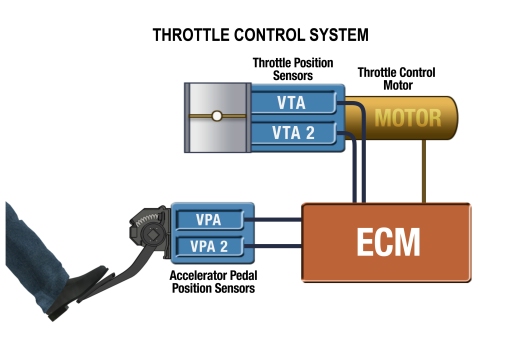
Although Toyota insisted there were no flaws or defects in the electronic and computer control system of their accelerators some suspected that sudden accelerations might to be linked to milage-boosting improvements modifications made by Toyota, the introduction of an electronic control-related device called the electronic throttle control, or ETC system — or to electromagnetic interference or software glitches in the system. The ETC automatically adjusts the engine’s fuel valve to the optimum level and is designed to cut off the fuel supply to the engine in the event of abnormalities.
Safety Research & Strategies (SRS), a Massachusetts-based consumer advocacy group, reported that Toyota’s acceleration problems first appeared in 2002, at around the same time the ETC system was launched. Toyota blamed the floor mats and vehicle trim that could jam the accelerator pedal in an open-throttle position if detached. This was followed by an NHTSA investigation, in 2003, and two small recalls in 2003 and 2007. But still the problems continued.
Congressional investigators told AP they believed that Toyota intentionally resisted the possibility that electronic defects caused the unintended acceleration problems in their vehicles and then misled the public into thinking the recall would fix the problem. Toyota said that was untrue and suggested that it and a U.S. trade body jointly probe the ETC system. Toyota also said that electro-magnetic interference could not affect the ETC system.
To support its claim that there were no defects in the electronic system, Toyota conducted an experiment before outside experts that the company said showed the system worked as they said it did. According to Toyota the experiment demonstrated that unless covers of multiple wires connecting the engine-control computer with the accelerator pedal are damaged and they touch each other, sudden acceleration will not occur. Chris Gordon, director the Center of Automotive Research at Stanford University, and one of the outside experts present, said that it was extremely unlikely that conditions that caused sudden acceleration in the test would occur in natural conditions. The test was held to counter testimony given at a Congressional hearing by U.S. Auto expert David Gilbert of Southern Illinois University-Carbondale, who said he recreated sudden acceleration in a Toyota by short-circuiting wires behind the gas pedal.
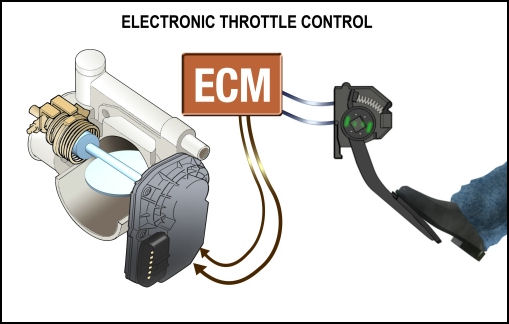
Figuring Out What Went Wrong with the Toyotas
Modern cars are very complex things, with over 20,000 parts. What’s more is they are becoming increasingly computerized. An average new Toyota has about 24,000 inputs and outputs and as many as 70 computer chips processing information and sending it to other chips to operate engine control units that are very complex. An average new automobile is about 60 percent electronic. Among the devices in new Toyota is an event data recorder — the automotive equivalent of a airplane’s black box — that record things like speed and engine RPMs and is used to deploy airbags and record information of what happened five second before a crash and two second after it.
Frank Ahrens, a Washington Post writer with an engineering degree, wrote: “The only way you can credibly figure out why something fails is to attempt to duplicate the failure under observable conditions...Toyota is facing an incredibly difficult task. Here’s what it knows: It has received hundreds of complaints of unintended acceleration in its vehicles over the past several years. People have died in these crashes. Over the same period, hundreds more people have died in Toyota crashes that nothing to do with runaway acceleration. After that, it knows nothing.”
“Toyota must search its data and look for patterns, for similarities among the incidents,” Ahrens wrote. “It must consider the kinds of road conditions where they happened (Is it a rain/snow/ sleet/ temperature problem?), where the cars were made (Is it a parts of assembly problem?), how the cars were drawn up (Is it a design flaw? If so, is it a mechanical or electronic flaw? Or a combination?), how the cars were tested (Did we fail to anticipate a series of events that would lead to a flaw?), if it is a fatigue problem (Did something break down sooner than we thought it would?) and a dozen other variables I’m not thinking of...Then you go through a process of elimination. It’s not dissimilar to a doctor diagnosing an illness: You take a thorough reading of the symptoms then start eliminating causes. You treat what you think is the illness. If it doesn’t go away, you treat your second guess at the illness.” When Toyota executives talked about using such methodology at a Congressional hearing they were mocked by some of the Congressmen, who were trained as lawyers.
Prof. Giorgio Rizzoni at Ohio State University , an expert in failure analysis, told Ahrens that the NHTSA bought a 2006 Lexus that experienced runaway acceleration and tested it every way the could. They attached a bunch of instruments and drove it for hours on a test track in an attempt to duplicate the problem. After that the car was taken to a lab and disassembled and tested. “If the electronic throttle is the suspected culprit,” Ahrens wrote, “it is removed from the Lexus and set on a test bench, where it is affixed with monitoring equipment and a power source. You give it juice and see what happens. If there are drops or surges in micro-voltage that could lead to runaway acceleration. If that doesn’t provide the answer, you go 21st century on the thing. You run something called a “hardware-in-the-loop simulation,” where you hook up the physical throttle assembly to a virtual Lexus, via a complex computer. This lets you test the throttle control up close while it is subjected to road conditions via computer simulation. You can run test for days on end without the expenses of a test driver.”
Rizzoni said the problem may be a software glitch. He said each vehicle on the road contains “layers of computer code that may be added from model year to the next” that control nearly every aspect of the vehicle. He said software is rigorously tested but “it is well-known in our community that there is no scientific, no firm way of actually, completely verifying and validating software.” Ahrens said: “If you put a lot of parts together to form a complex electro-mechanical machine and make it talk to itself via software, it can behave, sometimes, in way you cannot anticipate, It can fail for reason you can not anticipate.” He also added the problem could perhaps more easily be caused by human error (See Accidents Above).
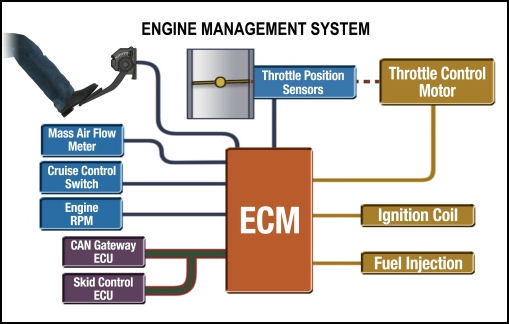
Blaming Toyota
The primary complaint with Toyota was that it acted too slowly on safety complaints and may have even tried to cover up safety problems. Documents have revealed that Toyota knew of the problems with sticking gas pedals at least in September 2009 but failed to issue a recall until January 2010.
Safety Research & Strategies (SRS) and other have pointed out the problem goes back much further than that. SRS had identified 2,262 instances of unintended acceleration in Toyotas leading to a least 819 crashes and 26 deaths between 1999 and 2009. It said there was an increase in unintended acceleration incidents in some Toyotas in 2002, around the time that Toyota introduced electronic throttle control (See Acceleration Flaws Above).
The National Highway Safety Traffic Administration (NHTSA) was also blamed for not taking bolder action when problems with Toyota vehicles were uncovered. In a NHTSA report issued in April 2008, for example, 59 of the 1,986 owners of Lexus ES350 cars surveyed said they had experienced “unintended, sudden acceleration.” Thirty-five of the 50 were using “all-weather” floor mat on the driver’s sides. The NHTSA only issued a “consumer advisory” on the matter and Toyota recalled 55,000 vehicles. Around the same time 100 complaints about unintended acceleration in Toyota’s Tacoma small trucks were filed with the NHTSA, with the regulatory agency doing little about it.
Reasons for the Problems in Toyota Cars
Many people, including executives at Toyota, have suggested that the root of Toyota’s recall and safety problems may have been Toyota’s rapid growth and obsession to be No. 1. Between 2000 and 2009 Toyota went from making 5.2 million cars to having the capacity to make 10 million cars and built 17 new production sites, which is almost the equivalent to added a company the size of Chrysler. Bill Saporito wrote in Time: “When Toyota opened its Georgetown, Ky. plant in 1988, hundreds of work team specialists and other experts were transplanted from Japan for several years to make sure the new plant full absorbed the Toyota way. That sort of hand-holding may still be possible, but it isn’t as easy.” University of Tokyo professor Takahiro Fujimoto told Time,” “Toyota faces excessive and overwhelming complexity that even its strong capability could not handle adequately.”
The extensive use of electronics and computers was also blamed. Management guru Kenichi Ohmae wrote, “New electronic complexity has overwhelmed its [Toyota’s] famous concept of “kaizen” from the bottom up” and “it has lost the big picture of how the hole electronic engine” and thus overall safety” works.” Ohmae feels that the kaizen system is outdated and a new system of “man and machine interface” needs to be installed so that big picture is not lost as work is broken down into thousands of details.
Wakatsuki, a former assembly line worker who formed an independent union at Toyota in part because of concerns about safet, ticked off a list of problems such as outsourcing key design work and shortening the trial-and-error period of new cars. “We used to test every one of our cars for safety and quality,” he told the Los Angeles Times, “now we do maybe 60 percent. The old days 100 percent is a thing of the past.”
John M. Glionna and Coco Masters wrote in the Los Angeles Times, “Many say the automaker privately set aside its "Toyota way" mantra of quality, becoming less cautious and more aggressive in its sales push to catch GM. It expanded too quickly and ignored its tradition of disciplined growth. And as its profits grew, it spent less wisely, some analysts believe.” [Source: John M. Glionna and Coco Masters, Los Angeles Times, January 31, 2010]
John R. Harris, a Tokyo-area communications consultant specializing in the auto industry told the Los Angeles Times, “"Underneath it all, they are still tremendously arrogant. They've been the gorilla of the industry long before they passed GM in the meaningless measure of sales volume."
Toyota’s Management and Problems in Toyota Cars
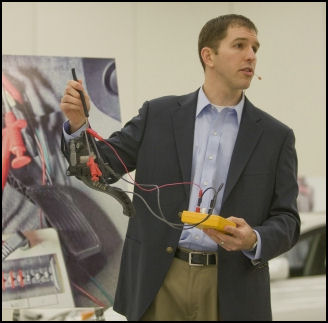
ETC Test Fumio Matsuda, a consumer advocate sometimes called the Ralf Nader of Japan, has been a critic of Toyota for some time. He told the Los Angeles Times that Toyota is the most secretive of Japan’s automakers and in the past it carried out “secret recalls” — in which vehicle owners were asked to visit dealers for vehicle check-ups. In these check ups defective parts were replaced and the owners was charged for the work but not told what was done. “Everything Toyota does is hidden,” he said. He said he believed the car maker knew of the problems in the recent recall long before going public, “I believe there will eventually be criminal charges. They knew there were problems with their cars, but they didn’t do anything until they were pressured.”
Among the problems that had been plaguing Toyota for years have been internal secrecy, a fear of authority and a distaste for sharing information between divisions. Some have said Toyota’s biggest problem has been not adequately addressing customer complaints and not having a system to address such complaints.
Some have accused Toyota’s upper management of being too absorbed in its own success, too insular, unable to adapt and change and out of tune with its customers. Kenneth Grossman, a marketing professor at Waseda University, told Time, “Their focus on the customers has been non-existent. Toyota is famous for having an arrogant culture. They’re so used to dealing with successes that when they have a problem, they’re not sure how to respond.”
Some saw the cozy relation between Toyota and the NHTSA, which should have put more pressure on Toyota to make recalls, as a serious problem. Internal documents revealed that Toyota officials visited with U.S. Safety regulators and “laughed and rolled their eyes in disbelief” over safety claims.
Documents, Memos and Toyota Misconduct
Among the evidence that Toyota knew about safety problem before it said it did, the Los Angeles Times reported, was a memo written in 2006 by long-time Toyota employees to senior executives, warning them about concerns over Toyota vehicle safety.
The memo pointed out that between 2000 and 2005, Toyota had recalled more than 5 million cars — 36 percent of all sold vehicles, a rate higher than other companies. The memo writers warned that Toyota’s failure to act may “become a great problem that involves the company’s survival.” They added, “We are concerned about the processes which are essential for producing safe cars...with production continueing in the name of competition.” One the memo writers Tadeo Wakatsuki later told the Los Angeles Times, “They completely ignored us. That’s the Toyota way.”
In a Toyota memo made public in February 2010 and written in July 2009 under the title “Wins for Toyota — Safety Group — Toyota officials boasted they had saved the company $100 million by successfully negotiating with the government to limited a recall of floor mats in some Toyota and Lexus vehicles. The memo was written in connection with an investigation of “sudden acceleration — in Camrys and Tacomos in 2007 that found “no possibility of the pedal interference with all all-weather floor mat if it’s placed properly and secured.” The memo listed seven “Wins for Toyota ,” such as “favorable recall outcomes — and “secured safety rulemaking favorably to Toyota — and outlined how phasing in air bags saved the company $124 million and 50,000 man hours and how delaying a rule for tougher door locks saved it $11 million.
Response by Toyota’s President
In February 2010, Toyota President Akio Toyoda appeared at U.S. Congressional hearings where he said “my family name is on every car...when cars are damaged, it is though I am as well.” He confessed he had not been told about certain aspects of the safety problems with accelerators, insisted there was no problem with Toyota’s accelerator systems, and promised that Toyota would become a “better and more transparent carmaker.”
CNN and CNBC broadcast the hearings live. The Los Angeles Times said that Toyoda’s testimony was “successful to come extent.” CBS News praised Toyoda for apologizing for an accident attributed to sudden acceleration of a Toyota vehicle and the New York Times commented on his use of an interpreter, which allowed him time to carefully consider his replies.
Many were impressed that Toyoda showed up at all. As he didn’t live in the United States he wasn’t legally required to. The grilling he endured was quite severe at times. For instance when, Toyoda said that Toyota’s problems might be rooted in Toyota’s push for rapid growth, one Congressman retorted, “The problems is not that you are moving too fast but that you are moving to slow.” In any event, Toyoda’s appearance seemed to signal that the peak of “Toyota bashing” was coming to an end and addressed criticism of Toyoda that he was hiding and shirking responsibility.
Toyoda met with American Toyota dealers and broke down into tears at an appearance before employees at Toyota factories. He told workers that Toyota was at a “crossroads” and the car maker needed to “advance safety to the next level” to restore consumer trust. He then flew directly from the United States to China where he met with local government officials and local reporters there and held a press conference in which he said, “I apologize to you from the bottom of my heart for causing concern and trouble in connection with Toyota’s recalls.”
“When you are facing a hearing like that and know the well-being of your organization is on the line, and literally the fate of thousands of people are on the line, it’s a sobering experience,” an American Toyota executive told the New York Times said of Mr. Toyoda’s appearance on Capitol Hill.
Investigations, Fines and Court Cases for Toyota

ETC Test Toyota safety problems generated criminal investigation as well as Congressional hearings. U.S. Federal prosecutors launched an investigation into Toyota’s safety problems. The Security and Exchange Commission launched an investigation into what the company told investors. And the FBI raided automobile parts makers that were suppliers for Toyota.
In April 2010, the U.S. government accused Toyota of hiding a “dangerous defect” and fined the company a record $16.4 million penalty — the maximum allowed by law — for failing to quickly inform regulators about gas pedal problems. U.S. Transportation Secretary Ray LaHood said, “We now have proof that Toyota failed to live up to its legal obligations. Worse they, they knowingly hid a dangerous defect for months from U.S. officials and did not take action to protect millions of drivers and their families.” The ruling posed a dilemma for Toyota . If it paid the fines the move could be viewed as an admission of guilt that could be used against it in court cases. Fighting the ruling could generate more bad publicity for the company. In the end Toyota paid the fine in part to avoid a resurgence of criticism against the automaker and having to go to court against the U.S. government to fight the charges.
As of April 2010, Toyota faced 138 potential class-action lawsuits over the depreciated values of recalled Toyota vehicles and nearly 100 personal injury and wrongful death cases in federal courts in the United States. A consumer protection lawsuit brought against the automaker in California claims Toyota engaged in fraud and endangered the public by selling defective vehicles and using deceptive business practices. Toyota wants the lawsuits consolidated and heard by a single judge if nothing else to reduce the legal costs presented by numerous cases. Also in the United States, Toyota shareholders sued the company over fallen stock prices, claiming Toyota executives misled investors and the public about the degree of the accelerator problem. Lawsuits were also filed in Britain.
Toyota’s Corporate-Wide Response to Safety Problems
In February 2010, Toyota said it would make public all information regarding product defects and promised to take another look for possible throttle defects with an external research institution and possibly the USTSA. Toyota had to tread cautiously: demonstrating openness, a desire to come clean and tackle its safety problems but not give away material that could used against the company in lawsuits against Toyota.
Toyota appointed a new chief quality officer for North America and gave him greater role in making safety-related decisions. It also gave regional branches more authority to make decision about recalls. In March 2010 Toyota said it would upgrade its event data recorders — outfit with devices that monitored the car’s acceleration — to gain a better understanding into what caused crashes. At the company’s first quality panel meeting in April 2010, Toyota promised to make quick decision making.
At the height of the anti-Toyota frenzy in the United States, Toyota ran a commercial entitled “Commitment,” in which it stated that “our company hasn’t been living up to the standards that you have come to expect from us or that we expect from ourselves” and the automaker was “dedicated to make things right.” To spearhead its American public relations strategy it hired the Glover Park Group, a consulting firm with strong connections to the Democratic Party in the United States, and ran advertisements but together by the high power advertising firm Saatchi and Saatchi.

2010 Prius RECALLED
Financial Impact of the Safety and Recall Crisis on Toyota
The recall crises wiped out more than $30 billion in share value and badly tarnished Toyota’s reputation. It occurred just as Toyota was beginning to pull itself up after the global financial crisis. Car sales dropped markedly in January and February 2010, with the drop in sales of Camry models particularly severe, and Toyota’s market share in the United States dropped from 18.2 percent in December 2009 to 12.8 percent in February 2010. Total sales in January was 98,796, the first time Toyota had sold less than 100,000 cars in the U.S. in 11 years. While this was happening Toyota’s rivals were posting strong sales and digging into Toyota’s market share. Ford did well on the back of sales promotion in which they offered Toyota drivers a $1,000 rebate if the switched from Toyota. General Motors and Hyundai made similar offers,
American car rental companies stopped rental of Toyota vehicles. American car companies smelled blood and began offering incentives directed at Toyota owners. GM offered a $1,000 rebate to any Toyota driver that switched to a GM car.
Toyota’s stock rose from $75 a share in October 2009 when floor mat recall was made to $90 a share on January 2010 when a recall involving gas pedals was made and then dropped 16 percent as of early March 2010 and then rebounded somewhat. The company was forced to shut down assembly lines at some of its U.S. plants to deal with the decline in sales.
In March 2010, Toyota’s new car sales jumped 40.7 percent and it held a 17.5 percent market share of the U.S. market, just below leader GM’s 17.6 percent. To attract buyers Toyota offered incentives it was reluctant to offer in the past such as interest-free loans, two years of free maintenance and discounted prices.
In February 2010, Toyota ranked third behind Honda and Subaru as the best all-around vehicle maker by Consumer Reports.

2010 Lexus GX RECALLED
Investigation of Sudden Acceleration
In August 2010, a preliminary report by U.S. government investigators from NASA and NHTSA investigating the sudden acceleration problem could find no new safety defects other than those already mentioned?floor mat entrapment and striking accelerator pedals. There was no evidence of an electronics problems.
Moreover of the 58 cars with event data recorders (vehicle black boxes) that were studied, 35 of them showed the brakes had been applied in the crashes. In about half of those 35 cases the accelerator pedal was depressed right before the crash suggesting that drivers were stepping on the accelerators rather than hitting the brakes. Fourteen cases showed partial braking. One cases showed pedal entrapment and another showed that both the brake and the accelerator pedal were depressed. Other cases were inconclusive.
In July 2010, based on its studies, Toyota said that “virtually all” of cases of sudden acceleration were caused by drivers pressing down on the accelerator rather than the brake. The car maker reviewed about 2,000 reports of unintended accelerations many of them in cars with event data recorders. Mike Michels, a Toyota spokesman told Bloomberg, “There are a variety of causes — pedal entrapment, sticky pedal, other foreign objects in the car and pedal misapplication.” When he was asked how many were caused by applying the accelerator instead the brake he said “virtually all.” There was no evidence of any electronic malfunction.
The U.S. government had said unintended acceleration of Toyota vehicles was involved in the death of 89 people. In May 2010, Toyota agreed to pay the record $16.4 million fine. In December 2010, it agreed to pay $32.4 million in new fines to settle an investigation into its handling if the floor mat steering rod recalls, bringing the total of fines that Toyota paid to $48.8 million. The fines were paid without admitting to violating any U.S. laws.
In October 2010, Toyota said it had not found a single case in which its vehicle’s electronic throttle control system would lead to unintended acceleration and that sudden acceleration complaints had shrunk by 80 percent compared with April. The same month Toyota announced it would equip all 2011 cars in the United States with smart-stop brakes, an advanced safety feature, as part of its efforts to regain the trust of American consumers. The system automatically reduces engine power when a vehicle’s brake and accelerator pedal are applied simultaneously.
In May 2010, U.S. transportation safety officials said they were going to investigate a 2005 Toyota recall to find out whether the company failed to promptly report a steering problem with its vehicles. In 2004, Toyota recalled Hilux pick up trucks, saying a weakness in steering relay system could cause steering problems. In 2005 some U.S. trucks were recalled with the same problems. Investigators suspect that Toyota may have known about the problem with the U.S. trucks before it said it did. Also in May 2010 U.S. Transportation Secretary LaHood met with Toyota President Toyoda and said that he was pleased with Toyota’s progress but the company faced more fines if it didn’t produce significant results in improving its safety.
U.S. Clears Toyota of Flaws in Electronics
In February 2011, the U.S. government said that electronic flaws weren't to blame for the reports of sudden, unintended acceleration that led to the recall of thousands of Toyota vehicles. In some cases, investigators suggested, drivers simply hit the gas when they meant to press the brake. "We feel that Toyota vehicles are safe to drive," declared Transportation Secretary Ray LaHood.[Source: Ken Thomas, Associated Press, February 10, 2011]
Ken Thomas of Associated Press wrote: “The investigation bolstered Toyota's contentions that electronic gremlins were not to blame and its series of recalls — involving more than 12 million vehicles globally since fall 2009 — had directly addressed the safety concerns. Transportation officials, assisted by engineers with NASA, said the 10-month study of Toyota vehicles concluded there was no electronic cause of unintended high-speed acceleration. The study, launched at the request of Congress, responded to consumer complaints that flawed electronics could be the culprit behind complaints that led to Toyota's spate of recalls.”
“Toyota said the report should "further reinforce confidence in the safety of Toyota and Lexus vehicles" and "put to rest unsupported speculation" about the company's electronic throttle control systems, which are "well-designed and well-tested to ensure that a real world, un-commanded acceleration of the vehicle cannot occur." Financial results and the government report boosted shares of the automaker on Wall Street by more than 4 percent, to close at $88.57.”
Analysts said the report would help Toyota's reputation but the company would still need to work hard to regain its bulletproof image of reliability. Toyota was the only major automaker to see a U.S. sales decline last year at 0.4 percent. "This is really something that is going to take years and years to recover," said Rebecca Lindland, director of automotive research with consulting firm IHS Automotive.
A Washington Post editorial read: “No abnormalities were found in more than 280,000 lines of software code that were analyzed. Radiation above and beyond industry standards aimed at the cars didn't cause them to suddenly accelerate. And the final report confirmed preliminary findings released last September. Data recorders - or black boxes - in the cars of those who complained of sudden acceleration found no evidence of mechanical error. What they did show was that the "most likely cause" was "pedal misapplication."
Was Toyota Unfairly Singled Out?
Micheline Maynard wrote in New York Times, “Ever since the Transportation Department stepped up pressure on Toyota over its recalls...two delicate questions have hung over regulators: Is the Obama administration trying to help the Detroit carmakers it bailed out last year by attacking Toyota? And, will those attacks lead to new trade tensions with Japan? ...In 2009 the Treasury Department provided $65 billion to assist reorganizations at General Motors and Chrysler, which both spent brief stints in bankruptcy.” Ray LaHood, the transportation secretary, said that Toyota was being held to the same standards as American carmakers. [Source: Micheline Maynard, New York Times, March 1, 2010]
A Washington Post editorial read: “Human error, mechanical errors that Toyota repaired and a dose of politically induced hysteria were to blame. The congressional hearings often were aimed more at generating headlines than getting to the bottom of a confusing situation. It’s right to ask tough questions of corporate executives and public officials. But the absence of restraint and perspective did not help get at the truth. Company officials were put in an impossible situation, since blaming Toyota customers — though this was true in many cases — would have been a public relations disaster.”
Asked whether he believed the stakes held by the Treasury Department in G.M. and Chrysler were influencing the Transportation Department’s actions, James E. Lentz III, president of Toyota Motor Sales U.S.A Mr. Lentz replied in a quiet voice: “I don’t believe that. The government is acting fairly.”[Maynard, Op. Cit]
“In Japan, however, conspiracy theories abound that Toyota is being unfairly punished by an administration eager to bolster the fortunes of the Detroit carmakers,” Maynard wrote. “In an analysis last week, the conservative Weekly Asahi magazine contended that President Obama also wanted to use the outcry against Toyota to lift his approval ratings.” “It’s doubly convenient for the Obama administration to hammer Toyota excessively,” the magazine said. “By picking on Toyota, Mr. Obama wants to reverse his falling popularity.” [Maynard, Op. Cit]
“Any criticism of Japan, whether from Toyota executives or lawmakers, feeds into fears by some in Japan, as well as in the United States, that the attacks are a resurgence of Japan bashing,” Maynard wrote. “Those concerns may have been intensified on Wednesday, when Representative Marcy Kaptur, Democrat of Ohio, pointed to a slide on a large television screen in the hearing room that depicted the United States trade deficit data superimposed over the white and red Japanese flag. Ms. Kaptur repeated a longtime criticism that Japan’s import restrictions make it nearly impossible for Detroit carmakers and foreign automakers in general to compete there. “Imagine the second-largest marketplace having less than 3 percent from someplace else,” Ms. Kaptur said.
Image Sources: Toyota
Text Sources: New York Times, Washington Post, Los Angeles Times, Daily Yomiuri, Times of London, Japan National Tourist Organization (JNTO), National Geographic, The New Yorker, Time, Newsweek, Reuters, AP, Lonely Planet Guides, Compton’s Encyclopedia and various books and other publications.
Last updated July 2011
